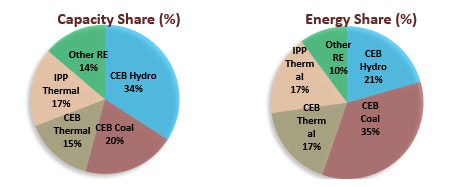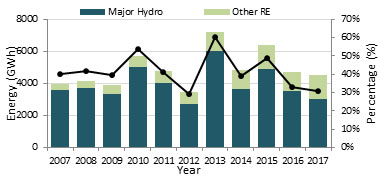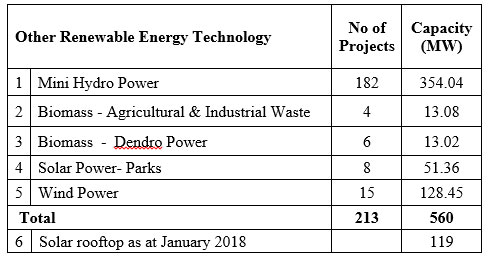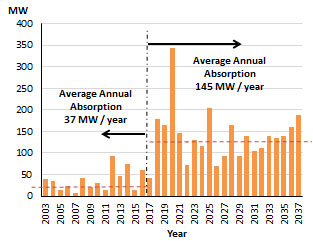|
(Article presented by EE&TC Sectional Committee based on public lecture held on 16th January 2018 by Eng. Buddhika Samarasekara, Chief Engineer (Generation Planning) and Eng. Dr. H.M Wijekoon Banda, Chief Engineer (Transmission Planning) of Ceylon Electricity Board)
The presentation consisted of the present status of the power system, results of Long Term Generation Expansion Plan (LTGEP) including proposed capacity additions & energy mix for the future, commitments to COP 21 & other environmental aspects, major projects in the pipeline, cost impact of different generation technologies and future transmission network development. Further the resource persons highlighted the increased focus on renewable energy power plant development including large scale solar and wind power parks. The presentation was concluded by identifying the financial impact of delays in project implementation and with the recommendation of commissioning the major power plants in the pipeline and transmission network developments identified for the period up to 2025 without further delay.
Present Status
Speakers described the present status of power generation and capacity shares as shown in Figure 1. It was highlighted that, 50% of the existing system capacity is comprised with renewable energy technologies and energy contribution is varied due to the dependency on the climatic conditions.
| |
 |
| Figure 1: Capacity & Energy share |
| |
| Promotion of Renewable Energy |
| |
|
|
 |
|
Sri Lanka has already harnessed its major hydro potential to its maximum level. Other Renewable Energy (ORE) development in Sri Lanka is very successful compared to other countries in the region. Figure 2 illustrates the historical contribution of Renewable energy sources for the total annual electricity generation. |
| Figure 2: Renewable energy Contribution |
|
|
| Table 1 illustrates the present status of Other Renewable Energy (ORE) as at 31st December 2017. |
| |
 |
| Table 1: Present status of ORE |
| |
When considering past 20 years, ORE cumulative capacity addition has been approximately 558MW. An aggressive renewable energy development is envisioned for next 20 years by maintaining optimum energy contribution from ORE power plants and it is planned to implement total cumulative capacity approximately 3,400MW. Out of this, major component is based on Solar Power Development (Rooftop Solar, 1MW, 10MW and Utility Scale Solar Parks) and Wind Power Development. Figure 3 demonstrates the average annual RE absorption for the past and the next 20 years. Average investment of 22 billion LKR per year need to be raised from year 2018 onwards excluding transmission network development cost in order to realize these ORE projects.
| |
 |
| Figure 3: Future projection of ORE capacity |
| |
Future Capacity Additions
According to draft LTGEP 2018-2037, next 20 years capacity additions will consist of 2,700MW Coal and 1,500MW LNG Combined Cycle Power Plants as major thermal based power plants. Major hydro development planned is around 240MW whereas Other Renewable Energy (ORE) including Wind, Solar, Mini Hydro and Biomass planned contribution is 2,800MW. Further 600MW Pumped Storage Power Plant is also planned to be implemented. According to most recent discussions and directions given by Oversight Committee on Energy to facilitate the government to government LNG combined cycle power plants, the base case of draft LTGEP 2018-2017 was revised. The energy mixes of the two cases are given in Figure 4.
| |
 |
| Figure 4: Energy mix in 2030 |
| |
When considering the major Coal power capacity additions they are proposed to be high efficient & eco-friendly Coal power plants. Higher efficiency reduces CO2 emissions and other proposed emission control technologies reduce SOx and NOx emissions to limits that comply with Sri Lankan and International standards. Further, adoption of indoor Coal storage facilities, closed conveyors for mitigating the Coal dust problems are also proposed.
Cost Impacts
Average cost at selling point for the years 2015, 2016 and 2017 were 15.06 Rs/kWh, 18.09 Rs/kWh and 21.32 Rs/kWh respectively. Accordingly, it can be seen that the average unit generation cost of electricity has been increasing over the past years. Speakers highlighted that the units generated from hydro and coal based sources would drive the CEB’s average generation cost down.
Further it was stated that the average selling price in 2017 was 17.54Rs/kWh.
Commitment of Sri Lanka to COP 21 and other Climate Change related activities
Speakers mentioned that Sri Lanka has adopted many policy measures for climate change adaptation and mitigation although emission levels are much insignificant compared to the global level.
Following commitments are undertaken by Sri Lanka, related to mitigation of GHG emissions from energy sector.
- Nationally Determined Contributions (NDCs)
Nationally Determined Contributions submitted to UNFCC by Sri Lankan National Designated Authority (NDA), Ministry of Mahaweli Development and Environment states that Sri Lanka expects to reduce 20% GHG emission in energy sector by 2030 against the Business-As-Usual scenario as unconditionally 4% and conditionally 16%.
These energy sector NDCs has been prepared based on LTGEP 2015-2034 and they are also incorporated in the draft LTGEP 2018-2037 Revised Base Case Plan.
- Amendment of National Energy Policy
- Contribution from Renewable Energy
- Clean Development Mechanism
- Carbon Partnership Facility
- Fuel Quality Road Map
- Loss Reduction
- Demand Side Management & Energy Conservation
Actual Cost of Delay in Implementation of Power Plants
PUCSL in their report ‘Financial impact of delay in implementation of power plants’ dated 11/10/2017 has indicated that the cost of delay in power plant implementation is more than LKR 50 billion. In contrast, the speakers highlighted that the actual cost of delays based on CEB observations is approximately LKR 2 billion which could be avoided with the timely implementation of the LNG combined cycle power plant at Kerawalapitiya. Further the cost of delay of Uma Oya hydro power plant will be LKR 4.6 billion which is a responsibility of all stakeholders related to development of Uma Oya Project.
Conclusion
Speakers concluded the presentation with the fact that Sri Lankan electricity generation is currently based on a mix of imported fossil fuels and local indigenous resources and Long Term Generation Expansion Plan further proposes to enhance energy security of the electricity sector by diversifying energy mix, diversifying fuel supply, increasing the utilization of Indigenous renewable energy sources (Wind, Solar, Mini Hydro, Biomass etc.) and initiate utilization of local natural gas.
Present transmission network is comprised with 132kV, 220kV lines and 132/33 kV, 220/132/33 kV, 220/33 kV, 132/11 kV, 220/132kV Grid Sub Stations. Speakers highlighted the constraints of present transmission network and emphasized the planned mitigatory actions by CEB including 400kV network development. Further it was stated that, the planned and ongoing transmission projects will enhance the network performance for future ORE development.
The speakers further emphasized that power sector development projects involve unique social & environmental characteristics such as public consultations, feasibility studies, bird migration studies and other social & environmental issues which need more than 1-2 years for clearance. Therefore, the responsibility should be shared among all relevant Governmental Institutions and encouraged to accelerate the development of the power project to minimize the impact.
Finally it was also concluded that the cost of electricity must be kept to a minimum to allow the increase of GDP per capita which will enable Sri Lanka to compete equally with the world economy.
|